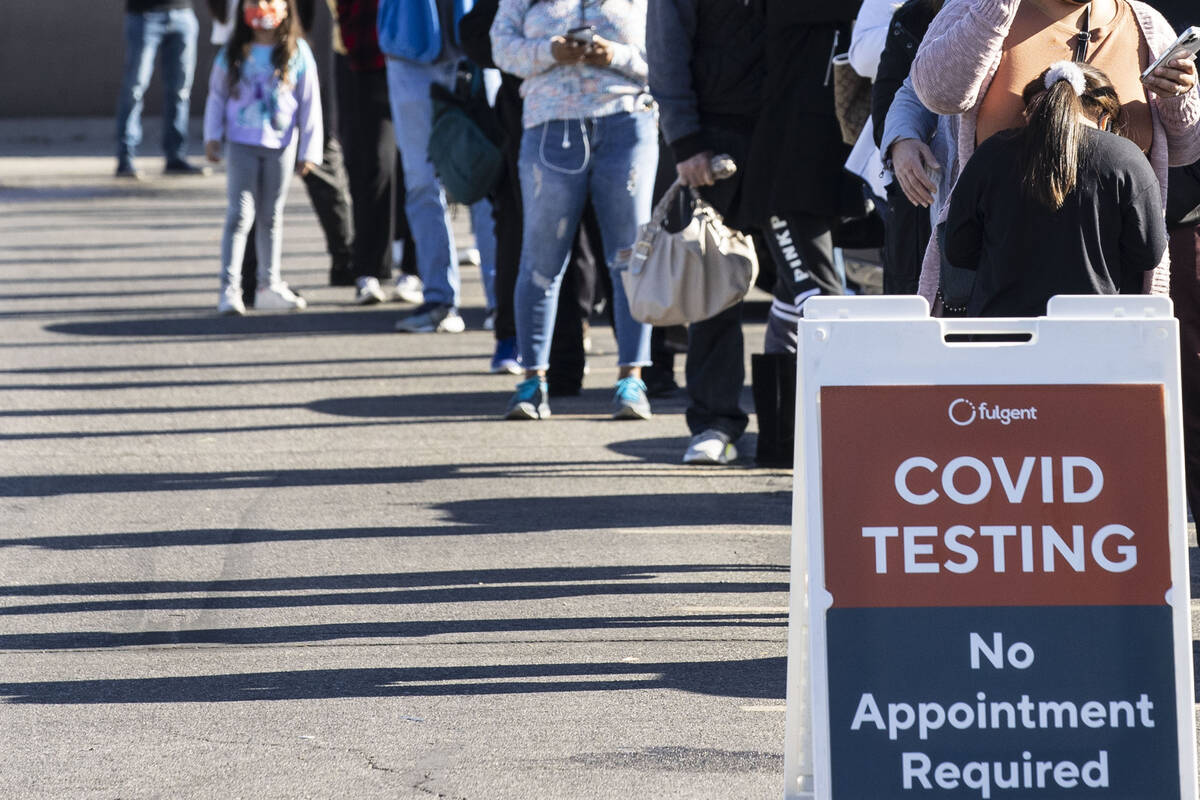Southern Nevada hospitals face ‘staffing crisis’ as COVID-19 surges
Hospitals in Southern Nevada and some rural parts of the state are facing a staffing crisis as COVID-19 related hospitalizations surge while large numbers of health care workers are getting sick and missing work, the Nevada Hospital Association said Wednesday.
“Nevada is experiencing an abrupt increase in COVID-19 hospitalizations, predominantly in the southern region following the holidays,” the trade group said in its weekly update on conditions in the state’s hospitals related to the disease. “People are flocking to hospital emergency departments seeking COVID-19 testing, compounding the staffing problem.”
The situation, the result of an omicron-fueled surge of the disease that is hammering the state and Clark County in particular, is worse in the southern and rural parts of the state, the hospital association said, explaining why it shifted the level of concern over staffing in those areas to the “crisis” level, the most severe category in its five-tier ranking system.
“In the south, COVID-19 cases have risen considerably over the past seven days, and significant numbers of hospital employees are testing positive for the disease,” the release said. “Hospitals are not overrun by a COVID-19 surge as much as being understaffed as employees in all fields report being sick and unable to work.”
The association also noted that large numbers of people showing up at hospitals seeking COVID-19 tests are contributing to the problem, as the Review-Journal first reported Monday. Hospitals have asked people not to do this — a plea reiterated by the Southern Nevada Health District on Wednesday — but long lines at most testing sites have led Nevadans to go anywhere they can to find an available test.
It stressed that the “crisis” designation “does not mean that patients with critical or life-threatening injuries or illnesses will be turned away from hospitals.” But it said that patients with “minor or non-threatening ailments … can anticipate excessive wait times, difficulty being transferred to a specific hospital or being admitted to the emergency department, and longer drop-times for ambulances.”
State passes 500,000 cases
The warning came as Nevada on Wednesday surpassed 500,000 COVID-19 cases since the start of the pandemic.
The state Department of Health and Human Services reported 2,779 new coronavirus cases and 20 deaths over the preceding day, pushing totals to 502,392 cases and 8,488 fatalities.
Nearly 16 percent of Nevada’s estimated population of 3.14 million has been sickened by the new coronavirus, which was first detected in late 2019 in Wuhan, China.
New cases of COVID-19 were well above the two-week moving average, which increased by 196 cases per day to 2,092. The 14-day moving average of daily deaths increased from four to five.
The state’s 14-day test positivity rate, which tracks the percentage of people tested who are found to be infected with COVID-19, increased by 2.7 percentage points to 18.5 percent, now well above the summer surge’s peak and less than 2 percentage points below the high of 20.4 percent, most recently recorded Jan. 14.
The number of people hospitalized with confirmed or suspected cases of COVID-19 in the state increased by 119, to 1,184.
Most state metrics for the disease — deaths being the exception — have been rapidly rising for weeks now, and public health officials believe they will continue to climb at least until late January.
County adds more than 2,000 cases
Clark County, meanwhile, reported 2,270 new coronavirus cases and 13 deaths during the previous day.
Updated figures posted by the Southern Nevada Health District raised the county totals to 381,724 cases and 6,512 deaths.
Data guide: COVID-19’s impact on Nevada
The county’s 14-day moving average of new cases increased to 1,866 from 1,695 on Tuesday, state data showed. The two-week moving average of daily fatalities, meanwhile, jumped from three to four.
Similar to the statewide metrics, the county saw a significant jump in 14-day test positivity rate, which increased 3.1 percentage points to 20.8 percent. The rate, which tracks the percentage of people tested for COVID-19 who are found to be positive, means more than one of every five Nevadans tested over the past two weeks were found to be infected.
The number of people hospitalized with confirmed or suspected cases of COVID-19 in county hospitals increased by 168, to 1,058.
State and county health agencies often redistribute daily data after it is reported to better reflect the date of death or onset of symptoms, which is why the moving-average trend lines frequently differ from daily reports and are considered better indicators of the direction of the outbreak.
Another long-term metric for the county offers a different look at the unprecedented level of of the disease caused by the new coronavirus in recent days.
‘A difficult couple of months’ expected
The county’s case rate per 100,000 people, as measured using the Centers for Disease Control and Prevention’s preferred seven-day average, increased to 792.78 on Wednesday afternoon. That is nearly double the rate of 400.84 cases posted on Tuesday and more than eight times higher than levels in early November, when the rate briefly dropped below 100.
Kevin Dick, district health officer for the Washoe County Health District, said at a news briefing Wednesday that the surge shows no signs of slowing down yet.
“I think it’s going to be a difficult couple of months that we have ahead of us, and I think people should really be trying to hunker down right now,” he said, adding that he expects key COVID-19 metrics to surpass those seen during the winter surge of 2020-21.
As of Wednesday’s report, state data showed that 54.67 percent of Nevadans 5 and older were fully vaccinated, compared with 53.99 percent in Clark County.
Contact Jonah Dylan at jdylan @reviewjournal.com. Follow @TheJonahDylan on Twitter.
Nevada vaccinations
— 5+ population: 3 million
— Doses administered: 4.00 million
— Vaccinations initiated: 1.95 million
— Vaccinations completed: 1.65 million
— Eligible fully vaccinated: 54.67 percent
Sources: Department of Health and Human Services; U.S. Census Bureau

















